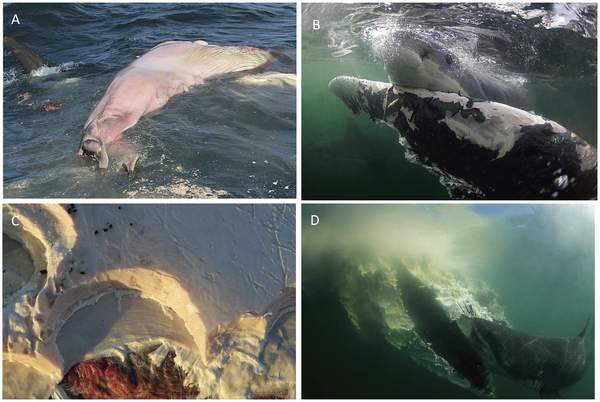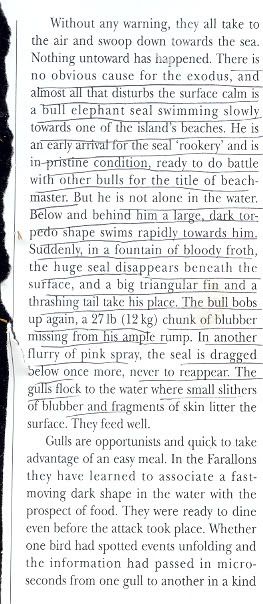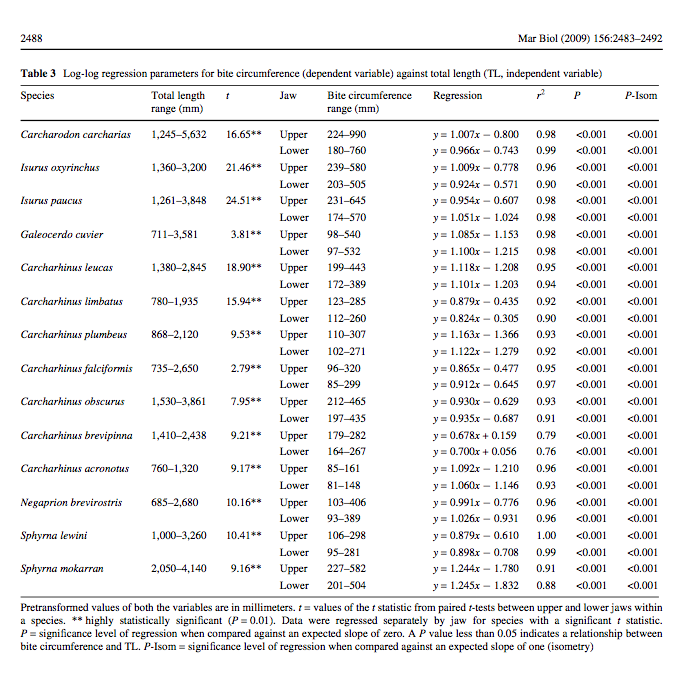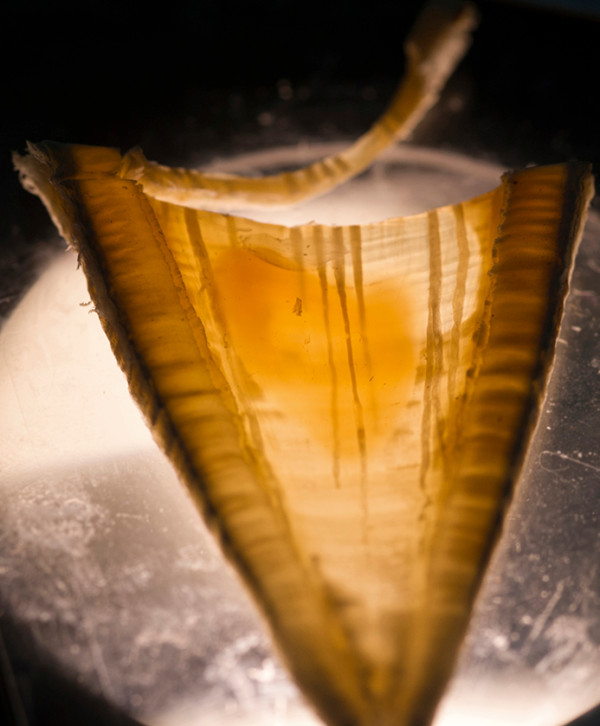|
|
Post by creature386 on Jun 18, 2013 0:51:29 GMT 5
Information on scavenging in great whites:  Figure 3. Examples of selective, facultative scavenging by white sharks on various whale carcasses in South Africa. Figure 3. Examples of selective, facultative scavenging by white sharks on various whale carcasses in South Africa.
(A) 4 m white shark removing and consuming a near-term fetus from a BrydeÂ’s whale carcass; (B) white shark scavenging on caudal peduncle and fluke of a BrydeÂ’s whale; (C) impression of a white shark bite on whale carcass through dermal, subcutaneous and blubber layer; (D) a white shark removing blubber around the jaw of a southern right whale carcass. Figure 4. Examples of unique behaviors employed by white sharks during scavenging forays on whale carcasses in False Bay, South Africa. Figure 4. Examples of unique behaviors employed by white sharks during scavenging forays on whale carcasses in False Bay, South Africa.
(A–B) A 4.5 m white shark removes a 20 kg chunk of flesh, sinew and blubber by performing lateral headshakes without employing protective ocular rotation.
Some information on the scavenging behavior now: Source: Fallows C, Gallagher AJ, Hammerschlag N (2013) White Sharks (Carcharodon carcharias) Scavenging on Whales and Its Potential Role in Further Shaping the Ecology of an Apex Predator. PLoS ONE 8(4): e60797. doi:10.1371/journal.pone.0060797 |
|
stomatopod
Junior Member
  Gluttonous Auchenipterid
Gluttonous Auchenipterid
Posts: 182
|
Post by stomatopod on Jun 18, 2013 21:09:52 GMT 5
|
|
|
|
Post by Grey on Jun 21, 2013 21:18:14 GMT 5
  A very large great white shark individual reported in the recent paper about size provided in the thread. This segment of the head was 1,35 m. |
|
|
|
Post by creature386 on Jun 26, 2013 17:26:26 GMT 5
|
|
|
|
Post by Grey on Jul 3, 2013 1:44:00 GMT 5
Very large fossil great white shark tooth from Summerville, South Carolina. 7,75 cm in slant height.  |
|
|
|
Post by Grey on Jul 7, 2013 14:01:46 GMT 5
|
|
|
|
Post by Grey on Jul 12, 2013 2:47:10 GMT 5
The encounter with the enormous "KANGA" specimen :http://elasmollet.org/Cc/Ken_Jury.html The scientific approach of it : elasmollet.org/Cc/Mike_Cappo.htmlSIZE AND AGE OF THE WHITE POINTER SHARK CARCHARODON CARCHARIAS (LINNAEUS); WAS PETER RISELEY'S WHITE POINTER A WORLD RECORD? By Michael Cappo, Research Scientist Austr. Inst. of Mar. Science (SAFISH 1988, 13, (1), pp 11-13) |
|
|
|
Post by Grey on Sept 4, 2013 13:07:57 GMT 5
news.google.com/newspapers?id=qWAdAAAAIBAJ&sjid=qVoEAAAAIBAJ&hl=fr&pg=6975%2C6623779In June 1978, 14 miles off Montauk, during a fishing trip, a large great white shark specimen is harpooned (once) by John Sweetman and his son in front of the other six people aboard the Ebb Tide. The fight will last more than 12 hours after which the shark broke free, and the fishermen returned empty-handed. Sweetman estimated the length of the shark in about 30 ft (9 m). His estimate is very likely an exaggeration but the individual was certainly very large and powerful.
|
|
|
|
Post by theropod on Sept 6, 2013 16:35:54 GMT 5
Not sure whether I ever posted this on this board, but these are the sharks >5m from the Elasmollet-list, and could prove helpful for estimating weights in extinct or unweighed specimens of lamniform, since at least the weight is a kind of average figure: gws_weight_elasmollet.ods (17.12 KB) I think several of these still had stomach contents included, so the result is rather a bit too high than too low, but it gives an idea. What is intriguing is that the scaling of weight in this sample is well below isometry, the ~5m specimens are far heavier or the ~6m ones far lighter than would be predicted by cubic scaling from each other, and the slope of my Log-transformed regression line is only ~2. I think this is rather due to the smaller ones being particularly heavy than the other way around. |
|
|
|
Post by creature386 on Nov 9, 2013 23:51:44 GMT 5
I just found this on CF:  |
|
|
|
Post by creature386 on Dec 13, 2013 20:12:33 GMT 5
|
|
|
|
Post by Grey on Dec 13, 2013 21:44:15 GMT 5
Simply not surprised ! There are several examples of the impressive durability and endurance of these animals, 400 MYA of survival do not mean nothing.
|
|
|
|
Post by creature386 on Dec 13, 2013 23:00:53 GMT 5
I'm not surprised either (we discussed this on carnivora already quite often), but I still think this fits into that profile.
|
|
|
|
Post by creature386 on Jan 7, 2014 0:53:05 GMT 5
astro.temple.edu/~tud02746/publications/Lowry%20et%20al.,%202009.pdf Estimating shark size from bite marks, this might be somewhat helpful for the Megalodon related discussion. It has beautiful figures and tables.  Here an example:  Page 2490 is highly recommended if you want to know how to use the formulas shown there.
|
|
|
|
Post by elosha11 on Jan 25, 2014 3:09:24 GMT 5
From earthsky.org/earth/great-white-sharks-live-almost-as-long-as-people
Great white sharks live almost as long as people
The oceans’ apex predators – great white sharks – are also among the longest-lived marine animals, according to new research by marine biologists at NOAA’s Northeast Fisheries Science Center and the Woods Hole Oceanographic Institution. The journal PLOS ONE published their paper on January 8, 2014. The scientists reported that radiocarbon dating studies had revealed that one of the sharks in their study was 73 years old when it died. The scientists said their work suggests increased age at maturity for some sharks, making them more sensitive to fishing pressure than previously thought.
Past research had placed lifespan estimates on great whites at about 23 years.
However, researchers knew that age estimates, based on the analysis of alternating opaque and translucent deposits on shark vertebrae, were difficult to interpret. It wasnÂ’t clear how those features related to a sharkÂ’s growth rate. Were the bands created annually, or were they related to other yet-unknown growth characteristics in sharks?

Alternating opaque and translucent bands are used to chronicle the growth of great white sharks. But the story told by the bands is not always clear. Image via Tom Kleindinst, Woods Hole Oceanographic Institution.
Lisa Natanson is a fisheries biologist in the Apex Predators Program at NOAAÂ’s Northeast Fisheries Science Center, and one of the scientists involved in this study. She said, in press release:
Ageing sharks has traditionally relied on counting growth band pairs, like tree rings, in vertebrae with the assumption that band pairs are deposited annually and are related to age. In many cases, this is true for part or all of a speciesÂ’ life, but at some point growth rates and age are not necessarily in sync. Growth rates slow as sharks age. Deposition rates in vertebrae can change once the sharks reach sexual maturity, resulting in band pairs that are so thin they are unreadable. Age is therefore frequently underestimated.
Using vertebrae from eight sharks — four males and four females — caught in the northwest Atlantic Ocean between 1967 and 2010, the scientists set out to determine the time intervals between the opaque-translucent deposit pairs using radiocarbon dating, a method for dating biological specimens by determining its ratio of carbon-14 to carbon-12. Samples were processed using an accelerator mass spectrometer, an instrument that directly measures the number of carbon-14 and carbon-12 atoms.
The researchers used a specialized radiocarbon dating technique, called bomb radiocarbon dating, that utilizes timestamps based on the amount of carbon-14 released into the atmosphere by aboveground nuclear testing from the early 1940s to early 1960s. Distinctive carbon-14 to carbon-12 ratio signatures can be correlated with known dates to provide better age estimates for a sample. Growth bands deposited on a living sharkÂ’s vertebrae during those periods would show a relative increase in carbon-14.
Bomb radiocarbon dating revealed that one male shark was about 73 years old when it died. The other three males were 9, 14, and 44 years old, and the females were estimated to be 6, 21 and 32 years old at death. The researchers also found that the opaque-translucent vertebrae bands were laid down annually in small- and medium-sized great white sharks, but as the animals got older, the bands were deposited too tightly to be distinguished.
Image credit: Greg Skomal, MA Marine Fisheries.
Great white shark via Greg Skomal, MA Marine Fisheries.
The International Union for Conservation of Nature Red List of Threatened Species flags great white sharks as a “vulnerable” species. Natason sums up the implications of these results in her press release:
With lifespan estimates of 70 years and more, white sharks may be among the longest-lived fishes. Sharks that mature late, have long life spans and produce small litters have the lowest population growth rates and the longest generation times. Increased age at maturity would make white sharks more sensitive to fishing pressure than previously thought, given the longer time needed to rebuild white shark populations.
Bottom line: Recent research into the lifespans of great white sharks show that they can live three times longer than previously thought. Radiocarbon dating of eight sharks show that one individual was 73 years old when it died. These results, published in the Journal PLOS ONE, are based on bomb radiocarbon dating of growth deposits in the vertebrae of eight shark.
|
|
















